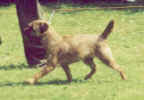Border Terrier anatomy from the ”essentially a working Terrier”
viewpoint, interpreted by Åsa Sandberg
This article has been published in breed club newsletters
of Sweden, Denmark, Holland and the USA.
Border Terrier conformation
from the
viewpoint of being “essentially a working Terrier”
In
Scandinavia, many Borders are still used to bolt foxes, and even more are being
used for hunting above ground. The breed attracts more fans every year, many
switching over from breeds where the split between “show” and “work”
lines is profound. For the sake of the overall quality of all Borders, and also
the size of the gene pool, I hope that this split will not arise in our breed,
especially since I find it a very unnecessary development in Borders. We are
lucky enough to have a breed
standard which is 100% describing a dog built to work well. We don’t have to
choose between beauty and function, since the correct looks in a Border Terrier
also provide the best possible construction for work. This article describes my
thoughts on some aspects of a functional conformation, and I hope for it to be
the start of a fruitful debate.
The
special, breed typical construction, different from many other long-legged
Terriers, is as I understand it the consequence of what Borders are required to
be good at: following a horse and going to ground. In most areas these two
demands push toward the same construction, since both parts of the job require a
strong, supple and fast dog with great jumping ability.
This influences among other things proportions and angulation. In other
areas the two demands are partly in anatomical conflict. The shape of the
ribcage is dictated by the fine balance between these two requirements.
Proportions
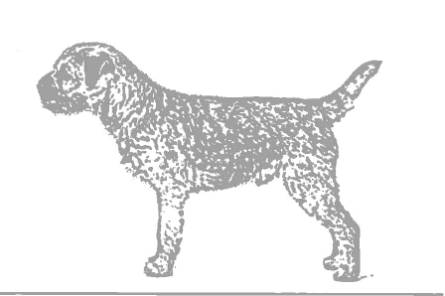
Fig 1 Normal-proportioned dog
This dog
is, although not perfect, in my opinion nicely proportioned and angulated. He is
a good mover and he doesn’t have to re-organize his body balance from
comfortable standstill to full speed. He is also more or less in his natural
coat – show grooming is a science in itself so I will leave the optical
illusions of this to the experts.
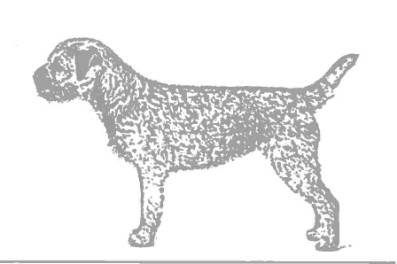
Fig 2
Longish bitch
In
bitches my personal preference is a little more length than in dogs although the
Border Terrier Standard, contrary to that of some other breeds, does not mention
a sex difference in proportions. To me it is part of a feminine appearance,
allowing space for puppies. Another is my impression that allowing more length
in bitches might make it easier to produce good proportions in both genders of a
bloodline.
A long
Border with normal length of leg can move just as well as a normal-proportioned
one as long as the body length is in the rib rather than in the loin.
A
bitch with proportions like in figure 2 will at times be criticized for being
short in leg although she is not. Her legs are the
same length as in the male, the difference is in the length of body only.
Fooling
the eye
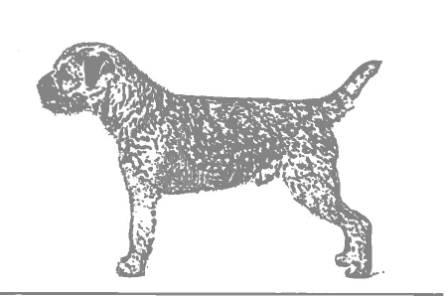
Fig 3 X
Fault: Fox Terrier front and
over-angulated rear
The eye
can be deceived in many different ways when subjectively assessing proportions:
shoulder angle, neck inset, tail carriage, even the colour markings of a dark
grizzle or a blue and tan (especially in “saddled” dogs). In this case the
source of illusion is angulation. This dog looks almost as long as the bitch,
but in fact he has exactly the same proportions as the dog in fig 1, only two
faults are introduced: a “Fox Terrier front” with a short upright upper arm,
and also over-exaggerated rear angulation which looks flashy when stacked but
may affect movement adversely.
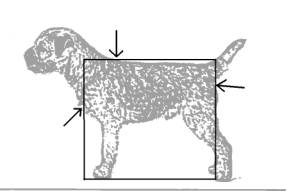
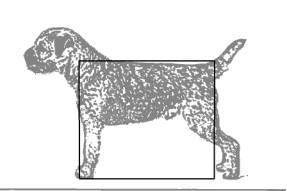
Fig 4 Proportions
marked in dog 1 and X
3
In the
FCI system, proportions are measured shoulder to ground compared to point of
sternum to back of pelvis. Unless otherwise stated in the Standard, the desired
proportions are 9:10 like in the dog to the left, i e the dog should be slightly
longer than tall. In the dog to the right, the upper arm is so badly placed that
the point of shoulder is hiding the point of sternum when viewed from the side.
This will seem to add a little length when measured in a photo. However, if the
dogs are compared in real life, the measurement may be made from the correct
points showing that these two dogs have exactly the same proportions.
The
American BT Standard calls for the distance shoulder to tail to be slightly less
than shoulder to ground, which is true for the dog in figure 1. Measuring this
way also clearly shows that the two dogs in figure 1 and 3 have the same
proportions although optically different.
Croup
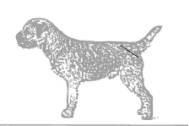
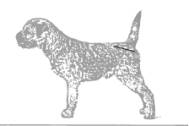
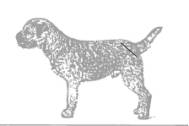
Fig 5 Left to right correct
croup, X too
flat (fault) and X
too sloping (fault)
A
correct Border tailset is “in the rear corner” rather than chimney-like.
This tailset often indicates that the croup has the correct length and slope,
like in the far left dog in figure 5. He is able to move immediately from a
comfortable standing position. This croup is also necessary for harmonizing
movement in a dog with a correct front assembly. A dog required to run all day
needs “four wheel drive”, he can’t afford to let either front or rear just
ride along not providing full propelling power.
All
three dogs in figure 5 have the same proportions, in spite of looking different
because of different croups. To achieve the same proportions, the middle dog had
to be drawn as short coupled. His croup angle will cause less rear angulation
unless his rear legs are longer than normal, both alternatives most likely
meaning less harmonic movements than the dog to the left. Most of his weight is
on the forelegs when stacked. In some of these dogs the rearward shift of weight
from standstill to movement is visible, especially when not on a tight show lead.
The
croup angle of the dog to the far right will force him to exaggerate rear
angulation, perhaps even to the point of sickle hocks as in the picture. Most
probably his loin will be arched when moving.
Ribcage
Since
Border Terriers are required to be able to run with the hounds during a British
fox-hunt we want speed and endurance. To get this, we need efficient movements
and plenty of room for heart and lungs. Earthdog work introduces the need for
going safely and at high speed into tight fox dens. This means the necessary
room can’t be created by a large
spring of ribs, because this will cause the dog to be wide and also not very
flexible in back. Instead the ribcage is required to be long and ribs well
carried back. Narrowness should not
be exaggerated either, since a too flat ribcage will not provide enough room for
long-distance running even if very long. The ideal cross-section is shaped like
a long strawberry, just like the measuring loop formed by the hands when
spanning the dog, thumbs at the dog’s back and fingers meeting at the lowest
point of the chest. This is why I feel that spanning, in spite of the
uncertainty of different sizes of hands, provides better information on ribcage
size than measuring with a tape which follows any shape closely.
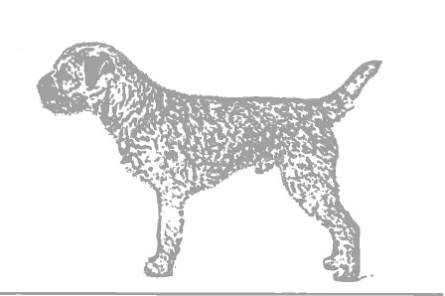
Fig 6 X
Fault: Short-chested
The
untypical tucked-up, weak loin of this dog indicates that the rib is not well
carried back. Proportions are the same as in the dog in fig 1, but the ribcage
is too short for a Border and the back ribs are not well developed. This is not
an ideal build for a dog that needs to run all day with horses and a pack of
much larger dogs.
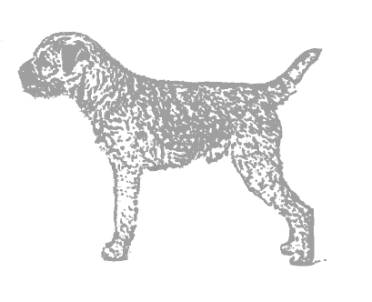
Fig 7 X Fault:
Quadratic
A
quadratic look, like in some other Terrier breeds, is very disturbing to type in
a Border. Also, I think being too short is worse than being too long, because
while both problems have the same influence on stacked looks a short dog may
also experience a negative influence on movement. Using a short step, crabbing,
or hackney-stepping are among the compensatory adjustments he may have to make.
He will
most probably also not have the desired flexibility in his back, necessary to
negotiate a problematic tunnel. When
I started showing Borders in the seventies, I experienced several times that
British judges tried the flexibility by bending the dog in a circle, checking
that the nose could easily touch the root of the tail.
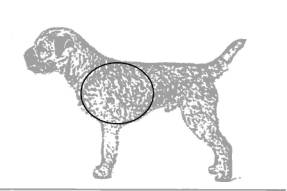
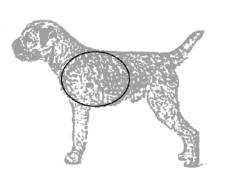
Fig 8 Rib cage length
in X short-chested
and X quadratic
dog
When the
actual size of the rib cage is marked in the drawing, a surprising result
unfolds: the tucked-up dog in figure 6, that has normal overall proportions, is
in this case just as short in rib as the obviously untypical, quadratic dog in
figure 7. What creates the illusion of the tucked-up dog being sufficiently long
is the added fault of being long coupled. This can’t be determined from
underline only, the only way to know is to feel along the sides for the position
of the last rib.
Fronts
A
correct ribcage shape, both sideways and in cross-section, is also necessary for
a correct front. Some forechest is needed for providing a correct front assembly
to body attachment, allowing free front movement. An oversprung ribcage will
interfere with mobility down a fox den, while a too narrow ribcage will not
provide enough room for stamina.
Running
with the hounds requires economical movement, where a long front stride is
provided by the upper arms moving along the side of the ribcage like in a hound,
rather than in front of the ribcage like in a “Fox Terrier front”. The Fox
Terrier front causes a pendulum movement where the foreleg swings forward but is
never carried very far back, while a hound front provides a smooth long step
with drive where the front leg is brought far back under the body as well as
reaching far out in front. This means a super-narrow front with no visible point
of sternum does not allow breed typical movement. Border Terrier people half a
century ago used to ask for four fingers width between the forelegs.
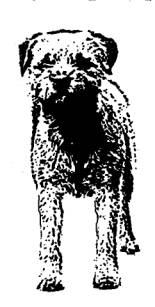
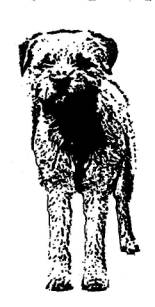
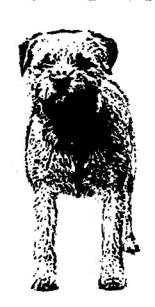
Fig 9 Left to right
correct front, X“Fox
Terrier front” (fault) and
X oversprung
ribs (fault)
In
figure 9, the dog at the far left has a correctly shaped ribcage and a good
front construction, providing excellent front movement.
The
ribcage of the center dog lacks forechest which allows for a very narrow front,
looking flashy when stacked but with untypical, restricted front movements. A
dog with a sideways view like in fig 3 could have a Fox Terrier front, or else
loose elbows as in fig 10, in front view.
The dog
at the right has an oversprung rib, causing a wide front and reduced sideways
body flexibility. This dog may also paddle when trotting at high speed, since
the rounded shape is often more pronounced mid-rib and will be in the way,
pushing the elbow out when the upper arm slides back along the rib in a long
stride.
However,
there are no ends to the variations in front construction and the ribcage is not
responsible for all of them. In fig 10 two dogs with correct spring of rib but
incorrect fronts are shown.
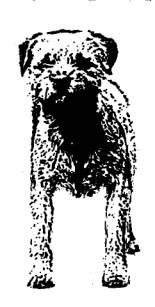
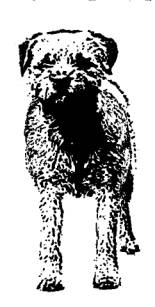
Fig 10 Left
X loose
elbows (fault), right X
heavy shoulder (fault)
To the
left is a dog with loose elbows. More often than not the upper arms are too
short and upright in a front like this. Although stacking can sometimes mask
this problem, it will be obvious when the dog is moving.
To the
right is a dog that may move well but is not suitable for earthdog work because
of a heavy shoulder, not smoothly blending into the body but rather bulging like
in a Staffordshire Bull Terrier. The sheer size of the shoulder is restricting
to tunnel work, and worse yet is the fact that this type of musculature is less
elastic than the desirable flat, stringy type, reducing flexibility when
negotiating tight spots down an earth.
Dual purpose
There
are many more examples to be found where the Standard describes the
best-functioning working Border Terrier. The only details dealing with beauty
only that I can find in the British standard are the V-shape of the ear and the
colour of coat, eyes and nose-leather. Every single other detail affects how
well the dog is able to work. In several other breeds that are still used for
their original purpose, either the show or the working bloodlines have trodden a
different path from the other conformationwise. I am glad this is not the case
in Borders since the most “beautiful” dog is also the one most well designed
to work. I hope that this will stay true in future.
| 